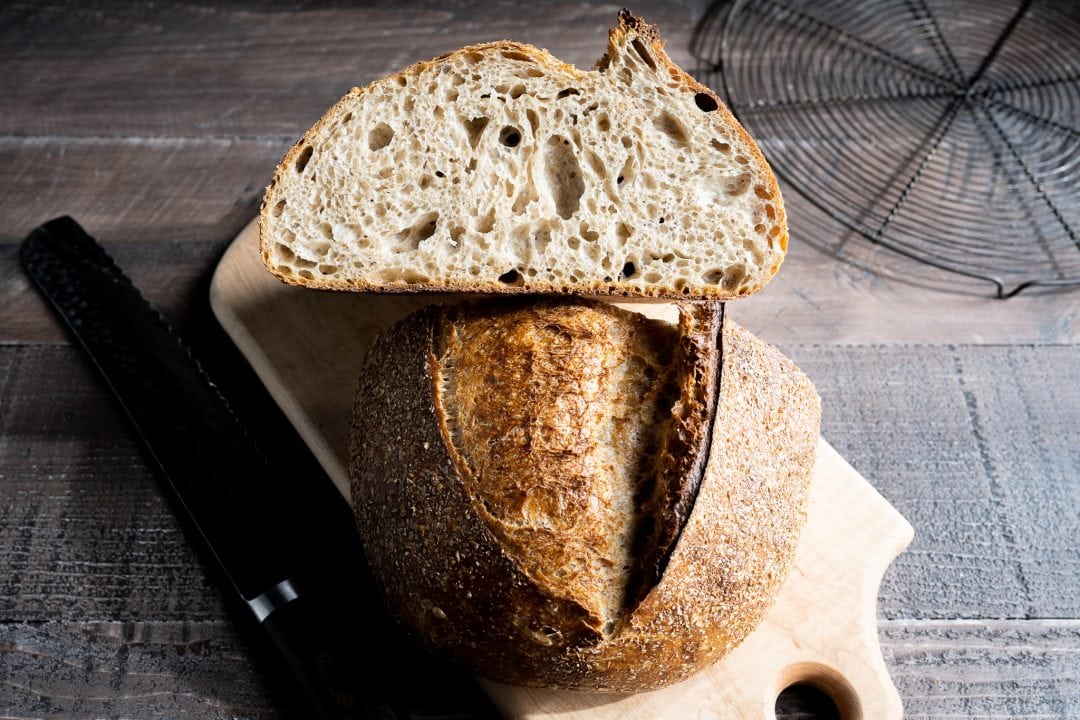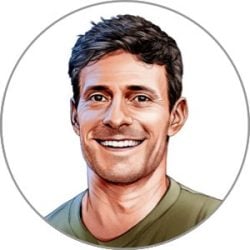I’ve been baking bread lately with an intensity that might verify my home as a full-fledged bakery. I’ve pulled rolls, sweet buns, pies, loaves, and many a pizza from my oven, and while they’re all satisfying in their own way, this sourdough with freshly milled Yecora Rojo felt perhaps the most satisfying of all.
This is a simple loaf of bread made with a sizeable portion of freshly-milled hard red wheat paired with medium-protein white flour—all at moderate hydration and mixed by hand. It’s a no-fuss bread where the taste far exceeds the few inputs, defying the adage “you get out what you put in.” When milling the fresh flour early in the morning to build my levain, the aroma is always the first to key my senses into the process. Milling has a way of drowning out any of the day’s activities and has a way of focusing; it’s like that surprise you know is coming yet still manages to ground you in the present with astonishment.
It is a simple bread to make, but a bread that delights.
And while I consider this bread simple, it does not fail to deliver on the flavor front. All the steps leading up to this loaf—from the fresh flour to the stiff levain to the long fermentation time—were done to maximize fermentation flavor and to highlight the inherent qualities of the freshly milled Yecora Rojo flour. It is a simple bread to make, but a bread that delights.
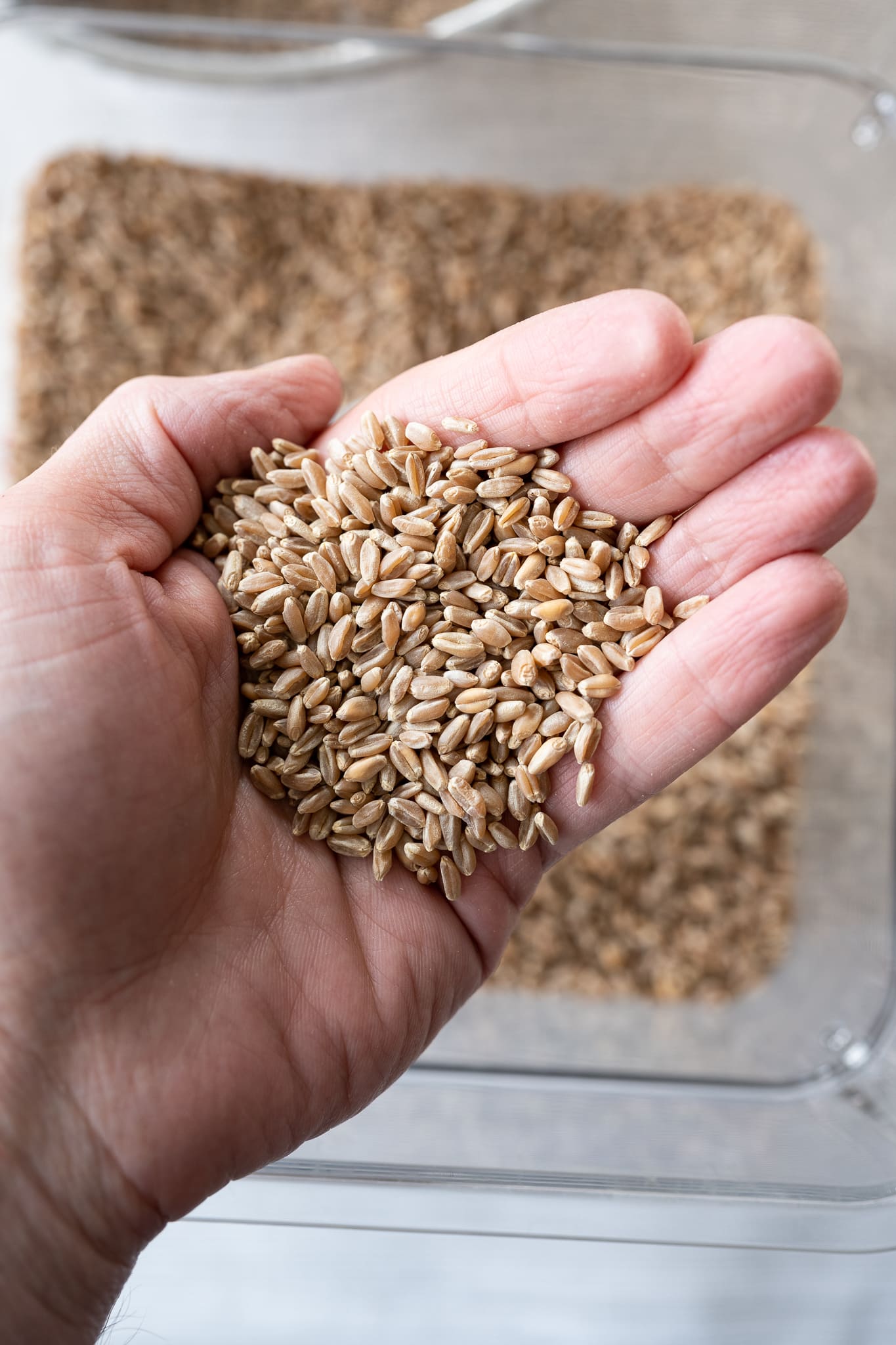
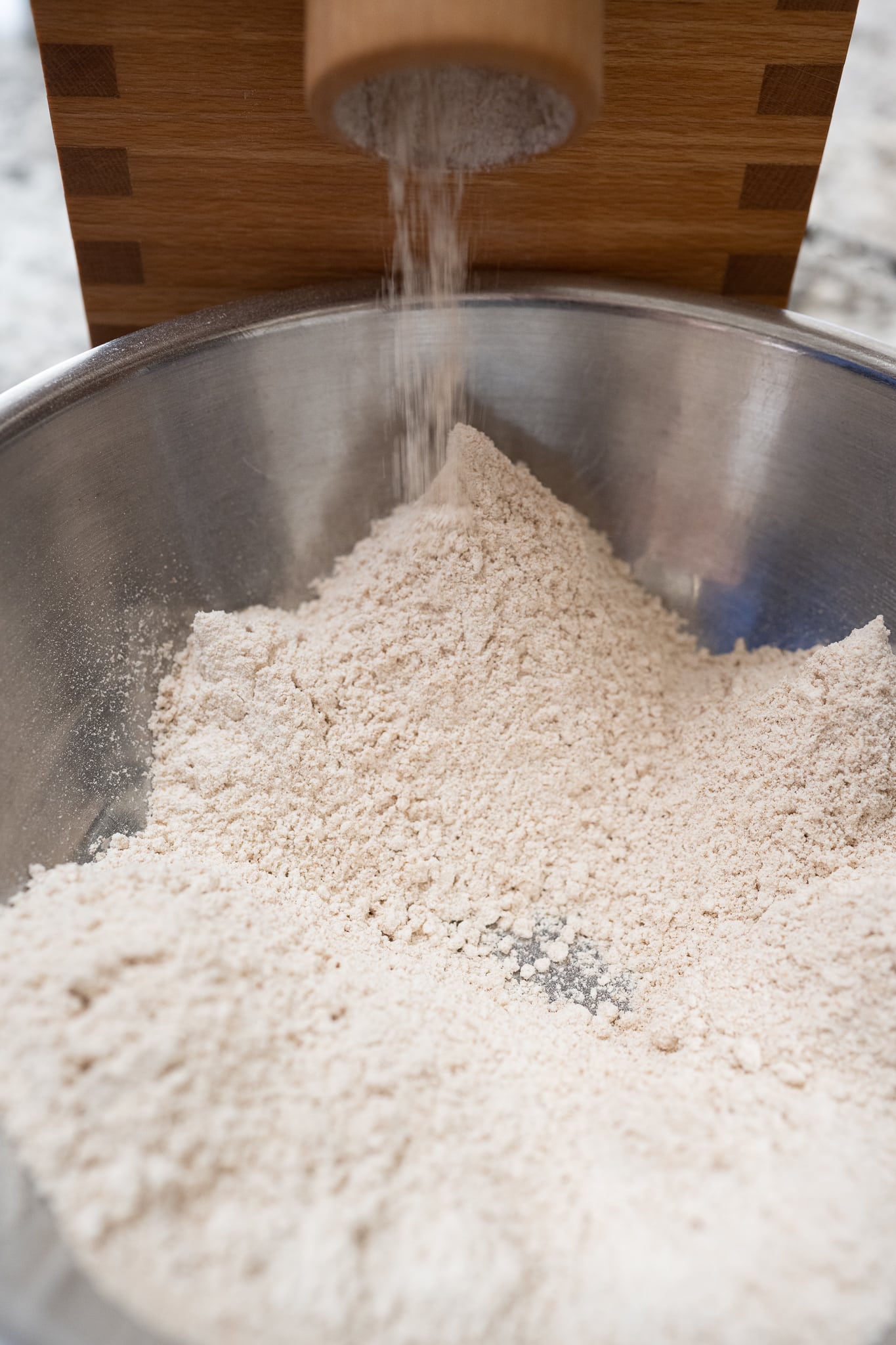
Flour Selection
Using freshly milled Yecora Rojo brings this loaf a swath of deep, wheaty flavors. Yecora Rojo has a rich flavor and pungent aroma that weaves through this sourdough bread recipe without being the predominant grain. It’s often described as having a “malty” flavor, and I concur; it tangentially reminds me of a mild light beer. Yecora Rojo is higher protein wheat with excellent baking qualities, and when paired with medium-protein white flour as the base, the result is a tender and open loaf. You can find Yecora Rojo wheat berries online over at Barton Springs Mill.
Barton Springs is a relatively close mill to the east of me in Texas, and while they’re not as local as I’d like, they’re still a fantastic option for those living in the Southwest.
If you don’t have Yecora Rojo, you could swap out that variety for any freshly milled hard red wheat with similar results but a different flavor profile. Review my guide to storing flour for the best way to store whole berries, freshly milled flour, and aged flour.
Using Wheat Bran to Top Bread Dough
To bring the nutrition up even higher and a great way to add texture to the crust, I like to top this bread with raw wheat bran. You can find small bags of wheat bran online, or you can sift the larger bran pieces out of any extra freshly milled flour. Either way, I roll the dough in the wheat bran right after shaping, just before placing it into its proofing basket.
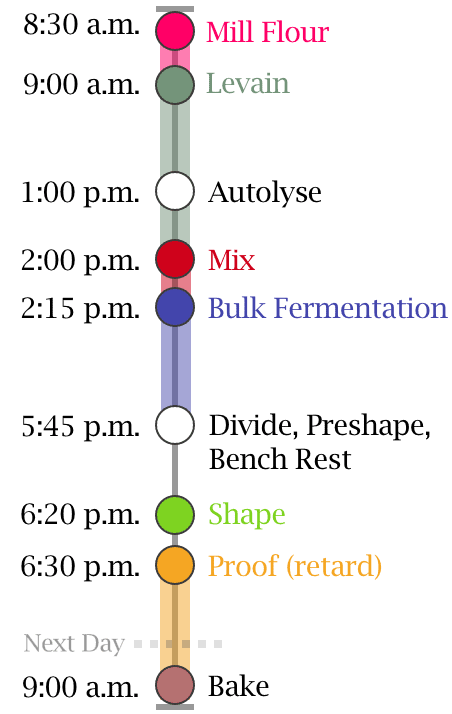
Because the dough is topped with the bran, dusting the proofing baskets with flour is unnecessary to prevent sticking.
Baking Schedule
As shown on the right, this sourdough with freshly milled Yecora Rojo wheat is made over two days. Cold-proofing this dough overnight brings additional flavor, and it’s also convenient for the home baker.
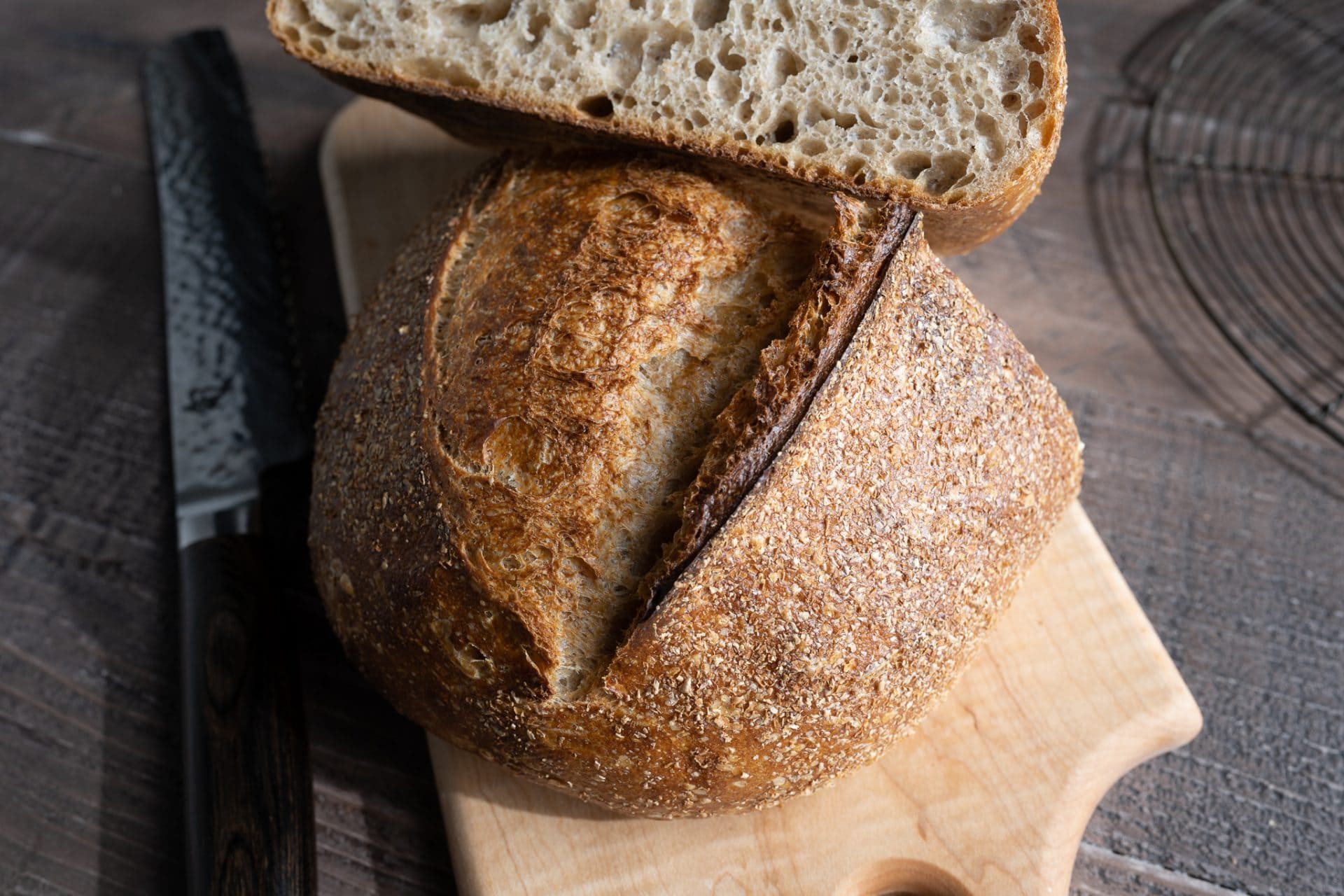
Sourdough With Freshly Milled Yecora Rojo Formula
Vitals
| Total Dough Weight | 1,800 grams |
| Hydration | 82.0% |
| Pre-fermented Flour | 6.4% |
| Levain in final dough | 13.7% |
| Yield | 2 x 900g loaves |
This recipe makes two loaves. If you’d like to make a single loaf, divide all the ingredients in half.
Total formula
Desired dough temperature: 74°F (23°C). This dough temperature is significantly cooler than my typical 78°F (25°C); I find when using a moderate percentage of freshly milled flour, the lower temperature helps rein in fermentation to more manageable levels. Check out my guide to dough temperatures for more information.
| Weight | Ingredient | Baker’s Percentage |
|---|---|---|
| 626g | Medium-protein bread flour or All-purpose flour (~11% protein, Central Milling Artisan Baker’s Craft or King Arthur Baking All-Purpose) | 65.0% |
| 337g | Freshly milled whole wheat (Yecora Rojo hard red wheat) | 35.0% |
| 722g | Water 1 (levain and autolyse) | 75.0% |
| 67g | Water 2 (reserve for mixing) | 7.0% |
| 17g | Fine sea salt | 1.8% |
| 31g | Ripe sourdough starter | 3.2% |
Sourdough With Freshly Milled Yecora Rojo Method
1. Mill flour — 8:30 a.m.
Set your grain mill to the finest setting and mill 337g Yecora Rojo (or any hard red wheat variety). I used my KoMo mill, but a Mockmill grain mill will also work well. Once you’ve milled the flour, set it aside until called for when making the levain and in the autolyse.
See my guide to freshly milled flour for information on grain selection, milling, and storage.
2. Prepare the levain – 9:00 a.m.
This is a relatively fast levain, ripening in five hours. Mix the following ingredients in a container and leave covered to ripen at a warm temperature, about 76°F (24°C) for 5 hours. Since this is a stiff levain (whereas my starter is liquid), I like to mix everything in a bowl to knead the dough slightly with my hands.
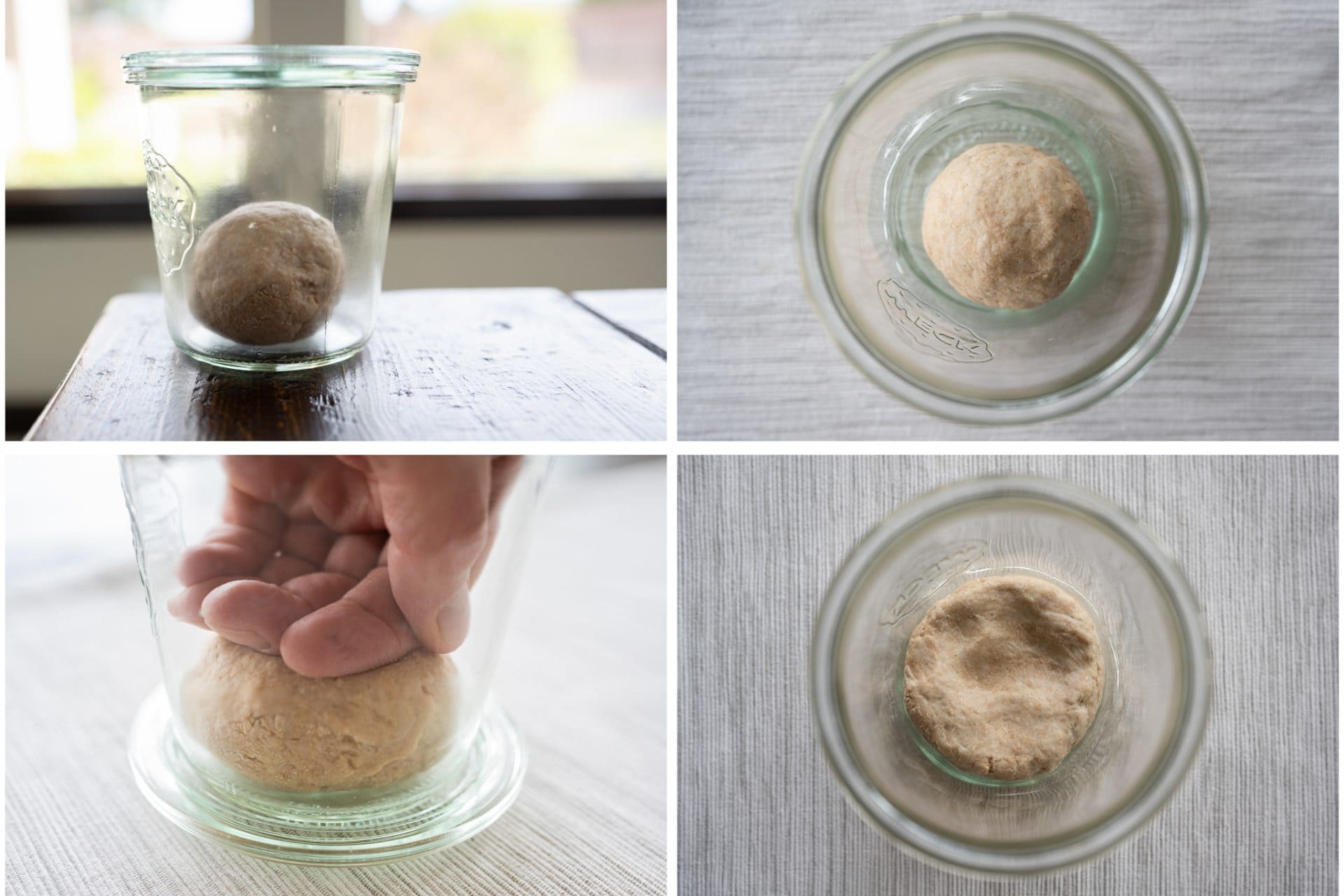
Note: I’ve built in a small 16g buffer to this levain. This means the levain will be a little larger than needed for this recipe to cover any loss (bits left on the side of the jar, spatula, etc.) when making.
| Weight | Ingredient | Baker’s Percentage |
|---|---|---|
| 35g | Medium-protein bread flour or all-purpose flour | 50.0% |
| 35g | Freshly milled whole wheat flour | 50.0% |
| 35g | Water 1 | 50.0% |
| 35g | Ripe sourdough starter | 50.0% |
2. Autolyse – 1:30 p.m.
This recipe uses a short autolyse to help decrease the required mixing time. Typically, I’m not particularly eager to autolyse with freshly milled flour, but this recipe works fine thanks to the small percentage of freshly milled flour and the grain’s inherent strength.
Add the following to a mixing bowl and mix until incorporated. Let the mixture rest, covered, for 30 minutes.
| Weight | Ingredient |
|---|---|
| 595g | Medium-protein bread flour or all-purpose flour |
| 306g | Freshly milled whole what flour |
| 691g | Water 1 |
3. Mix – 2:00 p.m.
Your stiff levain should look ripe at this point, showing bubbles at the sides, an expanded top, and a sour aroma. While this is a small levain, the large portion of freshly milled flour and high inoculation (the amount of ripe sourdough starter added) should ensure it is ready after 5 hours (as you can see below).
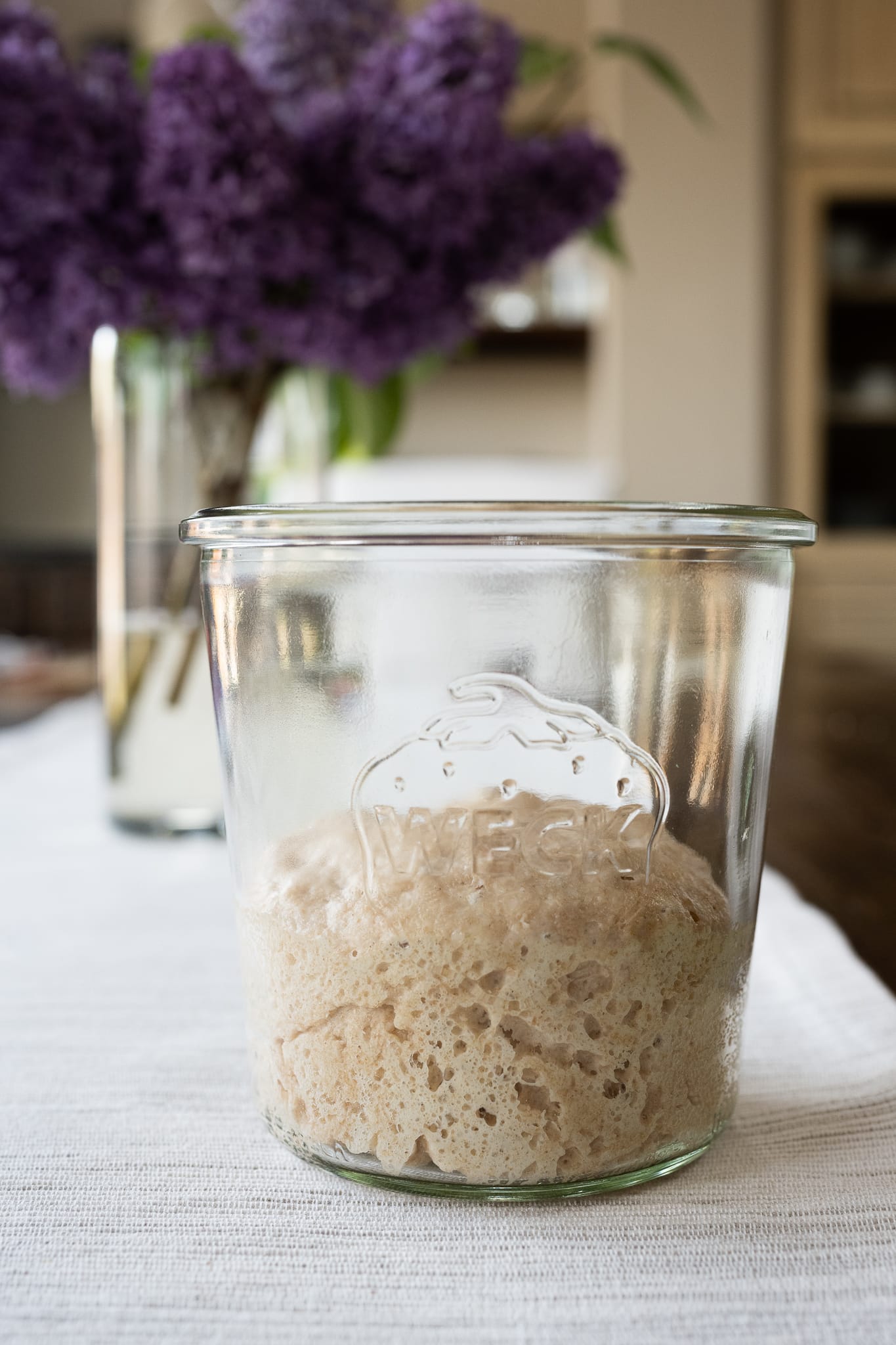
Gather the following ingredients for mixing. The remaining water (water 2) in the recipe should only be added through mixing if your dough feels like it can handle the addition. Use a splash to work in the levain and salt, adding the rest if the dough feels cohesive.
| Weight | Ingredient |
|---|---|
| 67g | Water 2 |
| 17g | Fine sea salt |
| 123g | Ripe levain (from step 1, you might have some excess) |
Sprinkle the salt over the dough and break up the stiff levain to scatter over the dough. Then, moisten with a splash of the reserved mixing water and, with wet hands, pinch, fold, and mix the dough until everything is homogenous. Scrape the dough onto a clean counter and slap and fold (knead) for approximately 5 minutes until smooth and showing signs the dough will hold itself together on the counter.
Transfer the dough to a container for bulk fermentation and cover.
4. Bulk fermentation – 2:15 p.m. to 5:45 p.m.
At a warm room temperature, around 74-76°F (23-24°C), bulk should take about 3 1/2 hours. If your kitchen is cooler, place your bulk container in a small home dough proofer, or extend the bulk fermentation time to give the dough more time to ferment. This dough needs three sets of stretches and folds during bulk fermentation.
See my guide to stretching and folding dough during bulk fermentation for details on this technique.
5. Divide and preshape – 5:45 p.m.
This dough won’t look excessively fermented after 3 1/2 hours in bulk fermentation, partly due to the low levain percentage in this formula and the low final dough temperature. This is what we want: it still has a long way to ferment until the fridge and even longer overnight (albeit at a cold temperature). You should see some signs of fermentation, including some rise, bubbles on the top and sides, and a smoothing of the dough (as you can see in the image below).
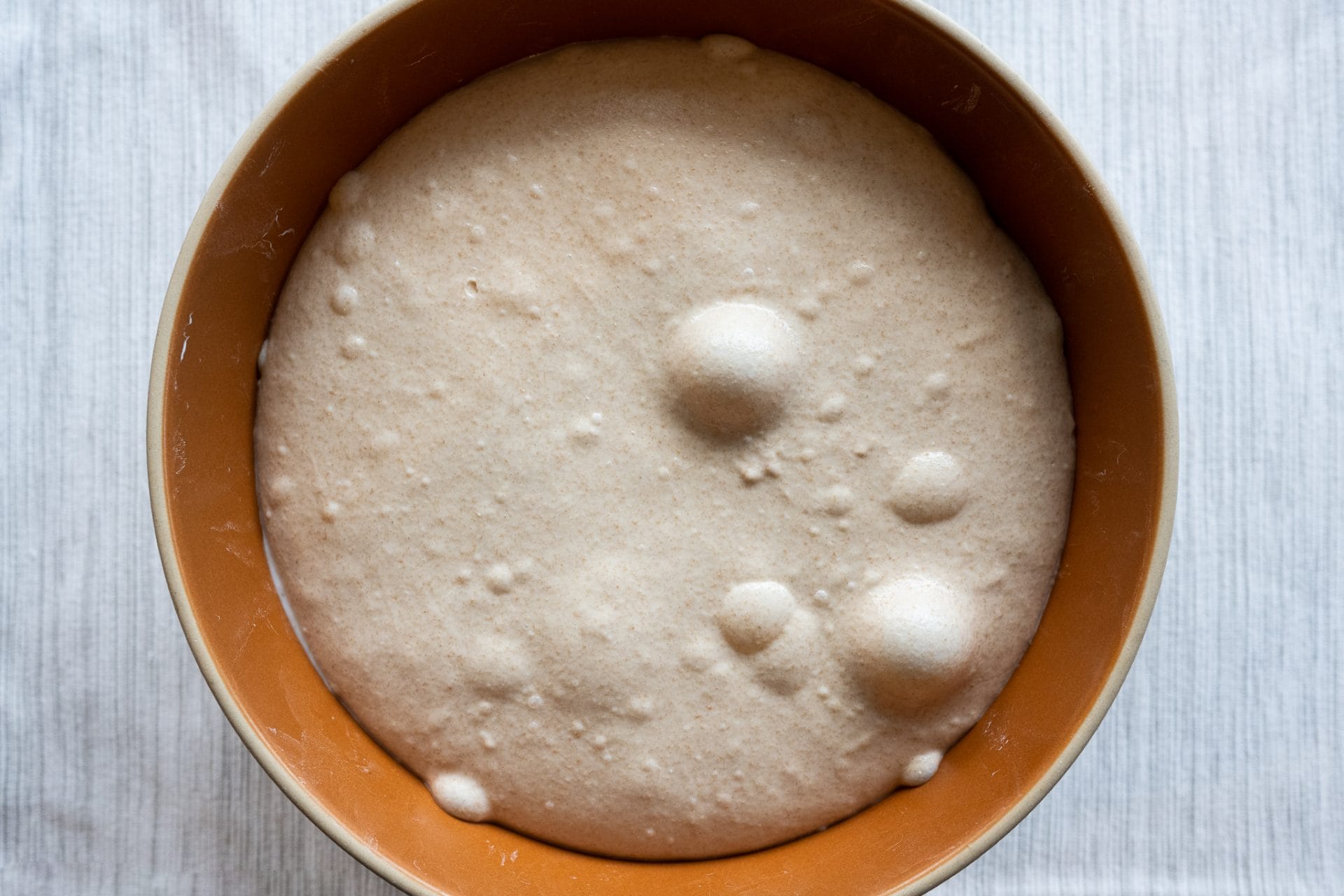
Fill a bowl with some water and place it on your work surface. Scrape out your dough from the bulk container onto your dry counter. Divide the mass in half using a bench knife. Using a wet hand and the knife in the other, gently preshape each half of the dough into a loose round.
Let the preshaped dough rest, uncovered, for 35 minutes until it’s relaxed outward.
6. Shape – 6:20 p.m.
First, optionally spread a thin layer of raw wheat bran on a clean kitchen towel, plate, or baking sheet and place it on your work surface. After you shape your dough, you’ll roll the smooth side on this thin layer of wheat bran to coat the exterior.
I like to shape this dough with freshly milled Yecora Rojo as a batard, but a boule would also work well. Shape each by flouring the top of the resting rounds and your work surface, flip the dough over to the floured space, and then shape them into your desired shape. Quickly and gently transfer the smooth side of your dough down onto the wheat bran and roll it side to side so the bran sticks.
Then, place it seam side up in a proofing basket lined with canvas or a clean kitchen towel. I used smaller 10″ oval cane bannetons for this dough to help provide structure and keep the loaf tighter through the overnight proof.
7. Proof – 6:30 p.m. to 9:00 a.m. (overnight)
Cover the baskets with a large, reusable plastic bag and seal it shut. Place the baskets into your refrigerator to proof overnight.
8. Bake – 9:00 a.m. (next day)
Preheat your oven with a baking stone or Baking Steel to 450°F (230°C). I baked these loaves in my Challenger bread pan, but you could also follow my guide to steaming an oven for baking bread.
Score each piece of dough and slide it into the oven—bake for 20 minutes with steam. Then, remove the steaming pans from the oven (or remove the lid to your baking pan) and bake for 30 minutes, or until the crust is deeply colored. The interior temperature registers around 204°F (95°C).
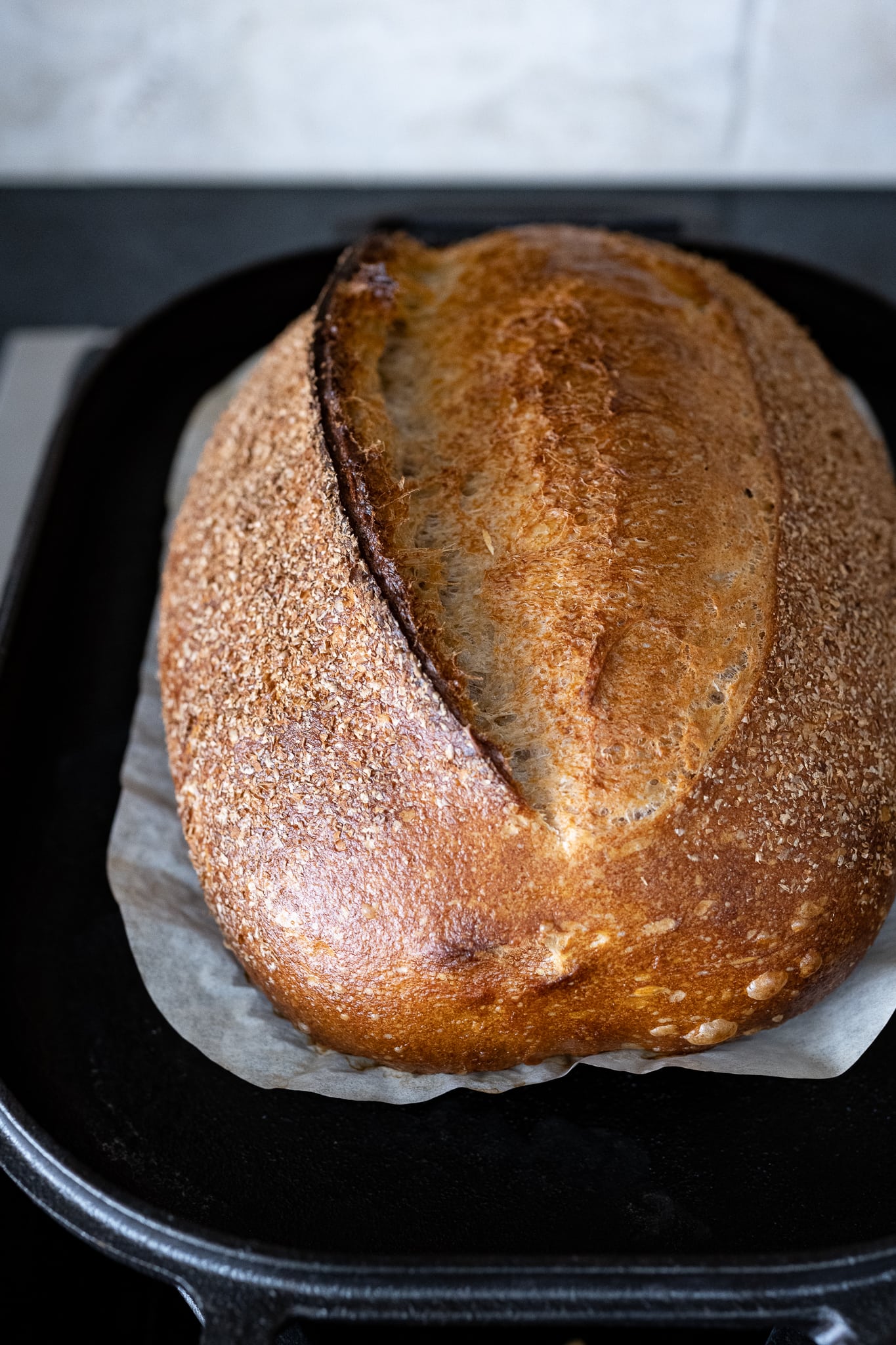
Once fully baked, cool your loaves on a cooling rack for 1-2 hours before slicing. See my post on the best way to store bread to keep it fresh for a week or longer.
It didn’t take much effort for me to want to continue test-baking this bread. The flavor and texture are so spectacular, and the simplicity of it all was so refreshing. Sometimes, removing complexity yields the best results, and it’s not often that we find the outcome exceeds the sum of the inputs, but when it happens, it’s all that much more satisfying. And what better way to start a week than to have fresh, wholesome bread made with a simple mix of flour, an effortless hand mix, and long-fermented for additional flavor and nutrition?
Buon appetito!
Print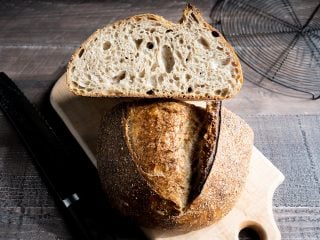
Sourdough with freshly milled Yecora Rojo
- Author: Maurizio Leo
- Prep Time: 24 hours
- Cook Time: 1 hour
- Total Time: 25 hours
- Yield: 2 loaves
- Category: Bread, Sourdough, Freshly Milled Flour
- Cuisine: American
Description
My recipe for a long-fermented loaf of sourdough bread with freshly milled Yecora Rojo at 35% to total flour. This loaf has a wonderfully tender interior and robust flavor thanks to the added whole grains.
Ingredients
Levain
- 35g medium-protein bread flour or all-purpose flour
- 35g freshly milled whole wheat flour (Yecora Rojo)
- 35g water
- 35g ripe sourdough starter
Main Dough
- 595g medium-protein bread flour or all-purpose flour
- 306g freshly milled whole wheat flour (Yecora Rojo)
- 759g water (water 1 + water 2)
- 17g salt
- 123g levain
Optional Topper
- Use raw wheat bran as an optional topper to coat the dough after shaping
Instructions
- Mill flour (8:30 a.m.)
Finely mill 337g of Yecora Rojo wheat flour (or another hard red wheat variety). I milled the flour on the finest setting on my KoMo grain mill. - Levain (9:00 a.m.)
In a small bowl, mix and knead the Levain ingredients. Transfer to a small container, cover, and keep it at a warm temperature for 5 hours. - Autolyse (1:30 p.m)
In a medium mixing bowl, add the 595g medium-protein bread flour, 306g freshly milled whole wheat flour, and 691g water 1 and mix until no dry bits remain. Cover the bowl and let rest for 30-minutes. - Mix (2:00 p.m.)
Sprinkle the salt over the dough and break up the stiff levain to scatter over the dough. Then, moisten with a splash of the reserved 67g mixing water (water 2) and, with wet hands, pinch, fold, and mix the dough until everything is homogenous. Scrape the dough out to a clean counter and slap and fold for approximately 5 minutes until smooth and starting to show signs the dough will hold itself together on the counter. Transfer the dough to a container for bulk fermentation and cover. - Bulk Fermentation (2:15 p.m. to 5:45 p.m.)
This dough will need 3 sets of stretches and folds during bulk fermentation where the first set starts after 30 minutes into bulk fermentation and the subsequent sets are at 30-minute intervals. After the third set of stretches and folds, let the dough rest, covered, for the remainder of bulk fermentation. - Divide and Preshape (5:45 p.m.)
Lightly flour your work surface and scrape out your dough. Using your bench knife, divide the dough in half. Lightly shape each half into a round shape. Let the dough rest for 35 minutes, uncovered. - Shape (6:20 p.m.)
Shape the dough into a round (boule) or oval (batard) and roll in the whole wheat bran to the top, if desired. Then, place the dough in proofing baskets. - Proof (6:30 p.m. to 9:00 a.m. the next day)
Cover proofing baskets with reusable plastic and seal shut. Then, place both baskets into the refrigerator and proof overnight. - Bake (The next day, bake at 9:00 a.m.)
Preheat your oven with a baking surface or combo cooker/Dutch oven inside to 450°F (230°C).When the oven is preheated, remove your dough from the fridge, score it, and transfer it to the preheated baking surface or combo cooker. Bake for 20 minutes with steam. After this time, vent the steam in the oven or remove the lid (you can keep it in the oven or remove it) and continue to bake for 30 minutes longer. When done, the internal temperature should be around 204°F (95°C).
Let the loaves cool for 2 hours on a wire rack before slicing.
Notes
- Instead of using Yecora Rojo for the whole wheat portion of this recipe, feel free to substitute it out for any freshly milled hard red wheat
If you use this recipe, tag @maurizio on Instagram so I can take a look!


